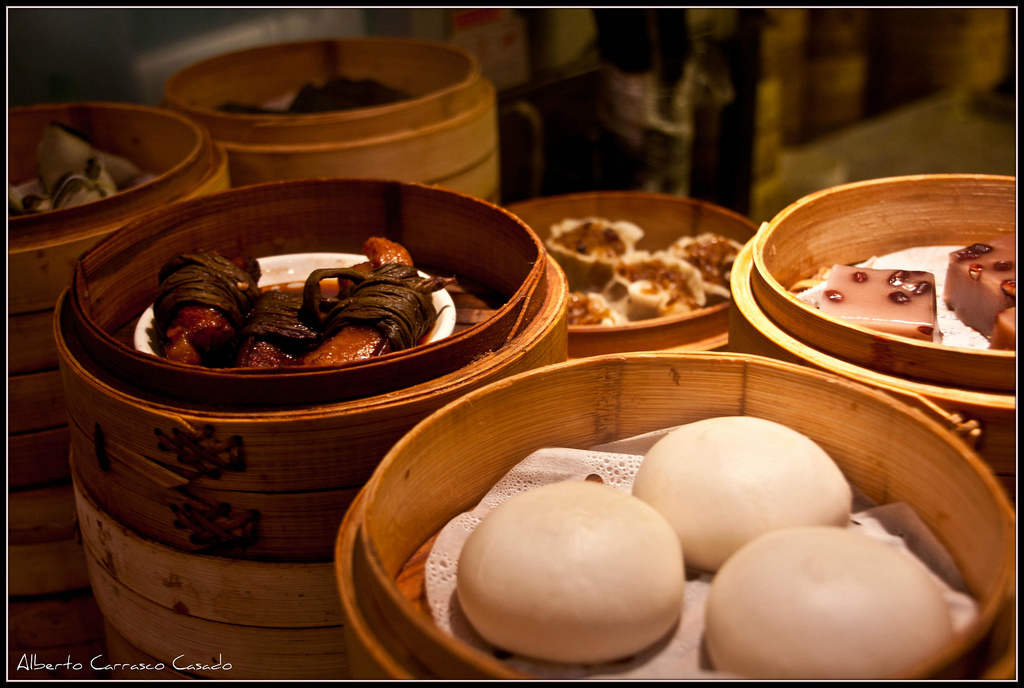
Steamed buns and other foods photographed in Shanghai. Photo © Albert Carrasco Casado, licensed Creative Commons Attribution.
The best way to look more like a local is to learn how to act like one at a restaurant. When you are seated, your table will be given just one menu for the entire group. If you are the host of a large group that covers more than one table, it is customary for whatever you order to be multiplied by the number of tables in your group, so that every table gets exactly the same dishes. If you struggle with using chopsticks, it is perfectly acceptable to hold a bowl up close to your mouth as you eat from it. Similarly, soup can be drunk from the bowl.You’ll be expected to pick one starch, or what the Chinese would refer to as a main food, which includes rice, dumplings, steamed buns, savory pancakes, or noodles. Although in the United States we can’t imagine eating Chinese food that isn’t piled on top of rice, the Chinese custom is to eat rice after you’ve finished all other dishes, just to fill up.
Many restaurants in China have aquariums and tubs filled with your potential dinner swimming and slithering about. If you order a meal with one of these delicacies, you may be required to either pick the one you want, or at the very least verify that the creature is still alive and healthy before the chef hacks into him. We found this out the hard way when we were encouraged to look into a plastic bag our waiter gingerly brought to our table and saw a very angry and very large snake hissing back at us. If they show you your critter before they cook him, control your urge to gasp and just give a quick nod to show your approval.
A shared meal in China is always very literally shared. All food will be delivered to the middle of the table and everyone will help themselves, using their own chopsticks to delve into the communal dishes time and again. If you are extremely cautious about the spread of germs, you can request serving spoons, although it is not the traditional Chinese way.
If you struggle with using chopsticks, it is perfectly acceptable to hold a bowl up close to your mouth as you eat from it. Similarly, soup can be drunk from the bowl. Chinese soup spoons are a ubiquitous option for the chopstick-impaired; few restaurants have forks, and knives are never used at the table. If the food comes too big to take in one bite, you are expected to hold it with your chopsticks and nibble off bite-size pieces. Gristle, bones, and shells can be quietly dropped onto the table next to your plate or into an unused bowl. Never leave your chopsticks sticking straight up in your food—this symbolizes death.
Concerning drinks, many restaurants provide a complimentary pot of hot tea before the meal. Tea is considered an appetite stimulator, not refreshment, so expect the teapot and the cups to disappear when your food arrives. At cafeterias, you are expected to use your soup as a drink. Glasses of water are not provided with meals, and ice is rare, although chilled soft drinks, beer, and bottled water are always readily available. The beer is often cheapest (unless it’s imported), but you’ll have to request it bing de (cold) if that’s how you like it, since many Chinese still prefer their drinks at room temperature. If you order water, you may get a cup of hot water—a common drink in cold northern climates. Requesting bing de bai kai shui will get you a free glass of cold water that’s safe to drink.
The cry of gan bei! is a toast that signifies everyone should drink down whatever alcohol is left in his or her glass. You can politely refuse to do so and just take a sip, though your companions may chide you. The Chinese find it incredibly funny to get a foreigner drunk, especially if you’re their boss, so watch out—their bai jiu (hard liquor) is rather potent!
Banquets are times to impress, and that means the most exotic foods. You may be treated to duck’s tongue, baby pigeon, fish-head soup, chicken feet, cow’s lung, pig intestines, scorpions, squid, and a whole lot more. Take only a very small amount of each dish, because you won’t believe how much food they will keep bringing. You’ll know the meal is over when the complimentary slices of fruit arrive. You will have to ask for mai dan (the check) when you are ready to leave.
In China, whoever does the inviting is the one who also does the ordering and the paying. Splitting the cost of a meal is rude by Chinese custom, though Chinese who are familiar with foreign ways may be open to it. Instead, the accounts are balanced when your guests later invite you out for a meal.
If it’s your birthday, you’re expected to treat your friends to a meal rather than being treated. We discovered this early on when we invited out a large group of Chinese coworkers to celebrate the birthday of a newly arrived fellow American, who was incidentally quite low on cash at the time. Lots of people came—and ate—without offering to pitch in a single jiao (dime), much to our unexpected chagrin.
Excerpted from the Second Edition of Moon Living Abroad in China.